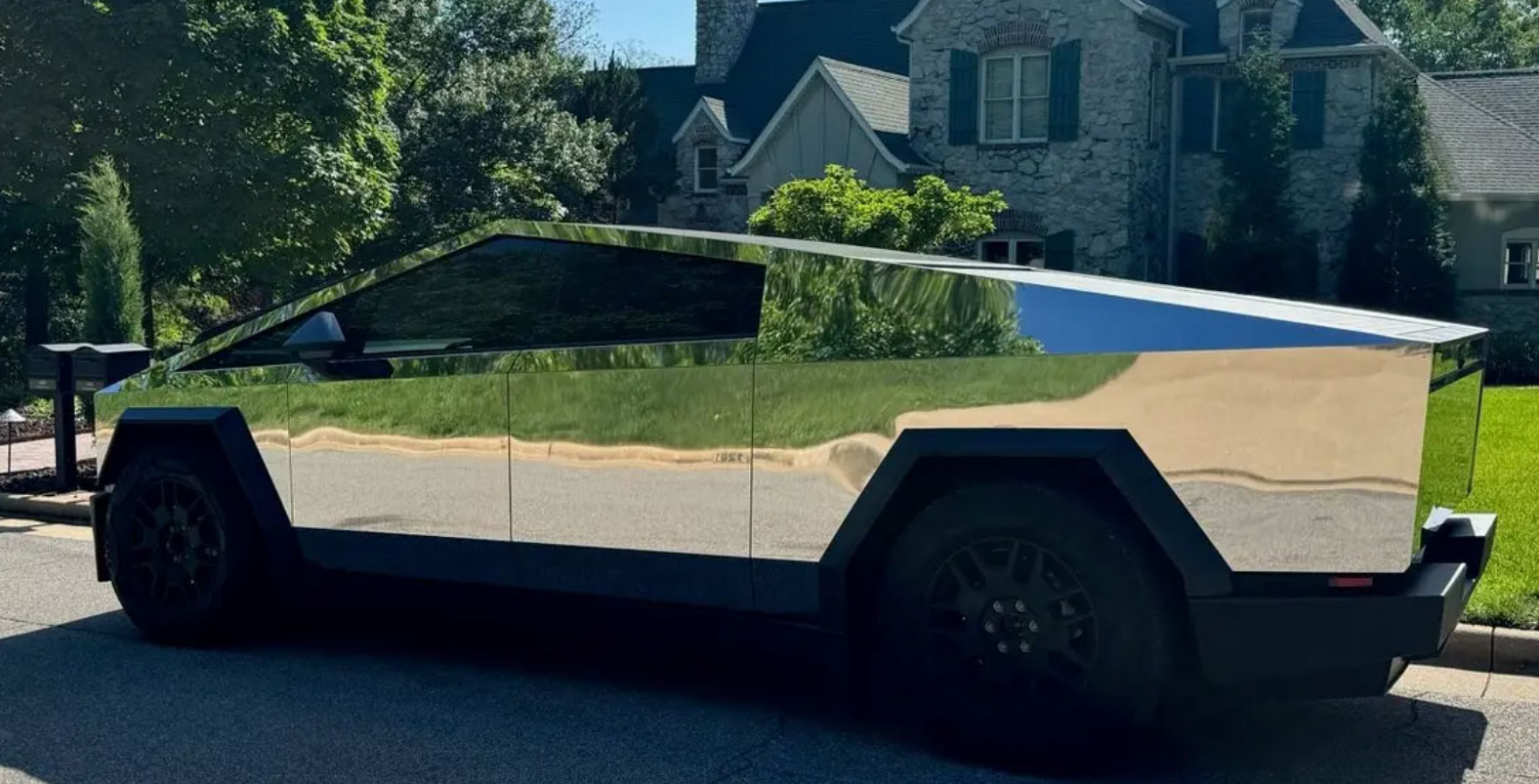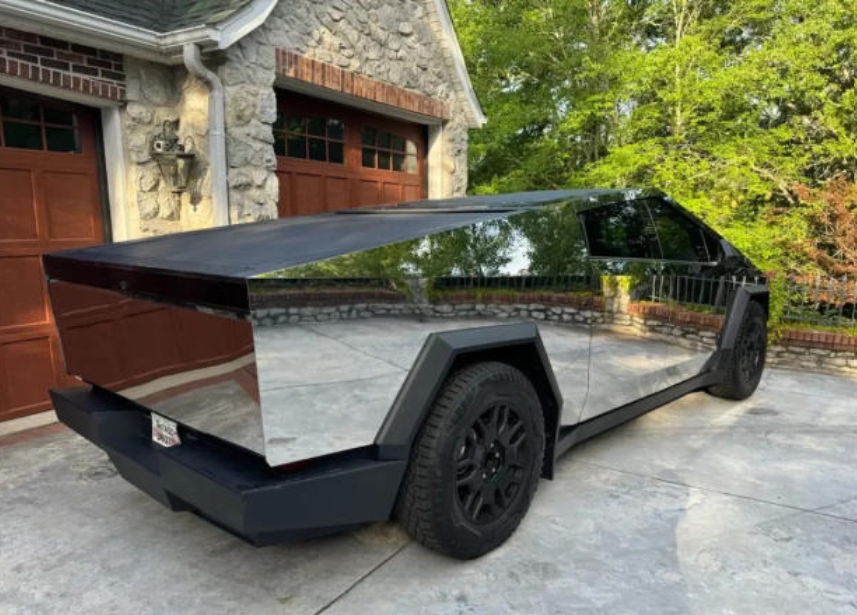Despite its sleek and polished exterior, this Cybertruck seems to pose a significant risk on the roads. Its futuristic design, complete with sharp angles and a reflective surface, though visually appealing, seems to disregard basic principles of road safety. The vehicle’s mirror-like finish, while aesthetically pleasing, could potentially blind oncoming motorists when sunlight or headlights reflect off of it, thus increasing the risk of accidents. Furthermore, the Cybertruck’s angular design is a far cry from the rounded shapes most common in cars today, potentially endangering pedestrians and cyclists in the event of a collision. Its size also raises questions about visibility and maneuverability.
Despite the evident design prowess and technological advancements, the Cybertruck’s apparent disregard for established safety standards could lead to catastrophic results on the road. The question then arises: should aesthetics compromise safety, or should the two go hand in hand, especially considering the advancements in technology today? The Cybertruck stands as a shining, albeit potentially dangerous, example of how the pursuit of design innovation may unintentionally overlook the essential aspect of road safety.

The Impact of a Polished Finish: Aesthetic vs. Safety
The impact of a polished finish on a product, whether it be a piece of furniture, a vehicle, or an architectural structure, can significantly affect both its aesthetic appeal and safety aspects. From an aesthetic perspective, a polished finish often imparts an air of elegance and refinement, enhancing the overall visual appeal of the product. It can create an impression of high-quality craftsmanship, contributing to a more enjoyable user experience. The polished finish may also help to highlight the inherent beauty of the material used, like the grain in wood or the luster in metal, offering a pleasing contrast or harmony with its surroundings.
On the other hand, the safety implications of a polished finish can be quite significant. For instance, a highly polished floor may pose a slipping hazard, particularly in areas prone to wet conditions, such as around pools or in bathrooms. Similarly, polished finishes on handles or grips can potentially decrease the ability to maintain a secure hold, increasing the risk of accidents. Also, certain polished surfaces may reflect light in a manner that causes glare, which could potentially impair vision and cause issues, particularly in driving or operating machinery scenarios.
In addition, the process of achieving a polished finish may involve the use of chemicals or treatments that could potentially be hazardous to health or the environment. Therefore, it’s essential to strike a balance between aesthetics and safety when opting for a polished finish. It might involve selecting less polished options for areas where safety is paramount or implementing additional safety measures, such as non-slip coatings or mats on polished floors. In conclusion, while a polished finish can significantly enhance the visual appeal of a product, it’s crucial to consider the potential safety implications and make informed decisions accordingly.
Analyzing the Cybertruck’s Reflections and Their Implications
The Cybertruck’s reflections are not only an aesthetic feature but also have profound implications on various aspects. The dynamic mirror-like exterior of the Cybertruck, made of stainless steel, offers a multitude of reflections that may alter the perception of the surrounding environment. This appearance serves a dual purpose of providing a unique design and contributing to the vehicle’s overall durability and resilience. The reflections, however, have implications that extend beyond the surface.
Firstly, they can potentially impact the comfort and safety of other road users. The reflections can be distracting or blinding to other drivers, particularly in bright sunlight or at specific angles. This could pose a significant challenge in maintaining a safe driving environment. Secondly, the reflections can influence the truck’s visibility and detectability by various sensors and systems used in modern traffic management and surveillance. These systems often rely on detecting the specific signatures or characteristics of vehicles, which could be distorted or obscured by the Cybertruck’s reflections.
Additionally, the reflections can affect the truck’s thermal performance, particularly in hot climates. The reflective surface can potentially increase the vehicle’s heat absorption, leading to a rise in the interior temperature and requiring more energy for cooling. Conversely, in colder climates, the reflections could potentially help in maintaining the vehicle’s interior warmth by reflecting back some of the heat radiated from the interior.
Furthermore, the reflections offer an interesting perspective on the relationship between design and functionality in automotive engineering. They highlight the tension between the desire for unique and innovative designs and the need for practical and sustainable solutions. This tension is likely to become more pronounced as the automotive industry continues to evolve and innovate. Therefore, understanding and managing the implications of the Cybertruck’s reflections is an important consideration for both Tesla and the wider automotive industry.

Additional Insights into the Cybertruck’s Design and Performance
Tesla’s Cybertruck, with its unconventional design and cutting-edge performance, has sparked a global conversation about the future of automotive industry. Its exterior, reminiscent of a futuristic armored vehicle, defies traditional design norms with its angular, almost origami-like construction, made from cold-rolled stainless steel. This material choice is not only aesthetically unique but also offers superior durability and resistance against deformation and corrosion.
Moving on to the performance aspects, the Cybertruck boasts an electric drivetrain that ensures instant torque for rapid acceleration. With a towing capacity of over 14,000 pounds and the ability to sprint from 0 to 60 mph in under 2.9 seconds, it challenges the capabilities of traditional combustion-engine trucks. Furthermore, the adaptive air suspension system promises a smooth ride, irrespective of the load or terrain. This system adjusts the ride height on the fly to optimize handling and efficiency.
The Cybertruck, with its off-road capabilities, also promises an all-electric range of over 500 miles on a single charge, an impressive figure for an electric vehicle, let alone a utility vehicle of its size. This range is a testament to Tesla’s advancements in battery technology and their commitment to sustainable transport.
The interior of the Cybertruck is as radical as the exterior, featuring a minimalist, utilitarian design. A single 17-inch touchscreen display takes center stage, providing all the necessary readings and controls. The six-seater cabin is spacious and uses durable, premium materials to ensure comfort and longevity.
Tesla’s Cybertruck represents a bold step forward in the evolution of electric vehicles, combining groundbreaking design with superior performance. Its capabilities and futuristic appeal have disrupted the conventional understanding of what a truck should be. As the market awaits its arrival, the Cybertruck continues to inspire and provoke thought about the possibilities of automotive design and technology.
